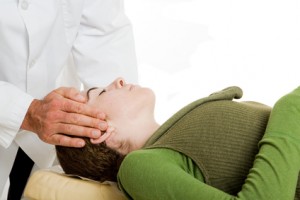 by Carol Douglass, R.N.
by Carol Douglass, R.N.
Craniosacral therapy for developmental delays, developed by Dr. John Upledger, is a gentle, relaxing, hands on therapy that can help children and families deal with some of the physical and emotional issues that are common to autism, ADHD, learning disabilities and Sensory Processing Disorder.
The Craniosacral System
The bones of the skull and the spinal column are encased in a three-layered membrane system called the meninges.
These membranes hold and protect the core of our nervous system: the brain, the spinal cord, and a clear, nutrient-rich fluid called the cerebro-spinal fluid. The dura mater (outermost meningeal layer) forms a fluid barrier, creating a semi-closed hydraulic system.
As the system’s fluid pressure rises and falls, it creates the craniosacral rhythm, a subtle expansion and contraction that can be felt anywhere on the body by a trained therapist.
The craniosacral system is crucial to overall functioning because it houses not only the brain and spinal cord, but the pituitary and pineal glands as well. These glands, in turn, regulate the entire endocrine system.
Tension in the Meninges
When the meningeal membranes cannot glide freely over one another, or if their capacity for motion is at all restricted, the system is compromised and symptoms may appear.
Traumatic injury, stress (physical or emotional), toxins in the body (environmental pollutants, drugs, etc.), prenatal problems, and a difficult birth can all compromise the craniosacral system. Sometimes it takes years for a structural problem to cause symptoms.
How Do I Know If CST Will Help My Child?
Everyday behavior is not a clear indicator of dysfunction in the craniosacral system. Unfortunately, there is no simple checklist of symptoms that signal tension in the meninges: it has to be felt by a therapist.
At the time of the first visit a craniosacral therapist evaluates the flexibility of the entire system, assesses the body from head to toe, and makes an appropriate recommendation. Children with a diagnosis on the autistic spectrum frequently have high tension in the meninges of the head.
Treatment with CST
Treatment consists of light touch manipulation, so subtle that an observer would notice almost nothing. Even recipients sometimes feel nothing.
The dura mater is attached at certain points to the bones of the cranium and the sacrum. What the CS therapist does is to use those bones as handles to tug gently at the dura mater.
This manipulation encourages the meninges to release tightness, to straighten out small kinks or stuck places, to recirculate fluid between its layers, and to regain its natural flexibility and symmetry of motion. Improving the environment of the nervous and endocrine systems in this way is beneficial for the entire body.
Sessions can range from fifteen minutes to an hour or more, depending on the child and the day. As in any therapy, there is no way to predict how an individual child will respond, but the gentleness and non-invasiveness of CST render it essentially risk-free.
Even extremely hyperactive children do surprisingly well after a few sessions. All of the children I have treated have developed increased tolerance for the work.
Of course it is always important to evaluate a child’s tolerance for hands-on therapy and to work within the limits of this tolerance.
A good introduction to CST, and a fascinating account of the origins of this new treatment, is the book, Your Inner Physician and You, by John Upledger, North Atlantic Books.
Results of CST
Symptoms caused by factors unrelated to the craniosacral system are not likely to change. When the problem is due to imbalance in the craniosacral system, the response is usually excellent, and can be dramatic.
Asked what the release of meningeal tension feels like, some children say, €œOh, nothing.€ Others experience powerful images and intense somato-emotional release.
Noticeable changes can occur in activity level, vision, allergies, sleep patterns, repetitive behaviors, and verbal communication. Self-destructive behavior can decrease or disappear.
Craniosacral therapy will also complement and enhance other interventions and there is no therapy I know of that doesn’t work well in combination with it.
CST is also a wonderful way for parents to recharge and unwind. Care givers need care too and children feel good about sharing their experience with other family members.
To learn how to become a craniosacral therapist contact the Upledger Institute: (800) 233 5880 or website, www.upledger.com
Carol Douglass is an Upledger trained craniosacral therapist in New Paltz, NY. She treats individuals of all ages with emotional, learning, and developmental disorders. You can reach her at (845) 255 9277.
